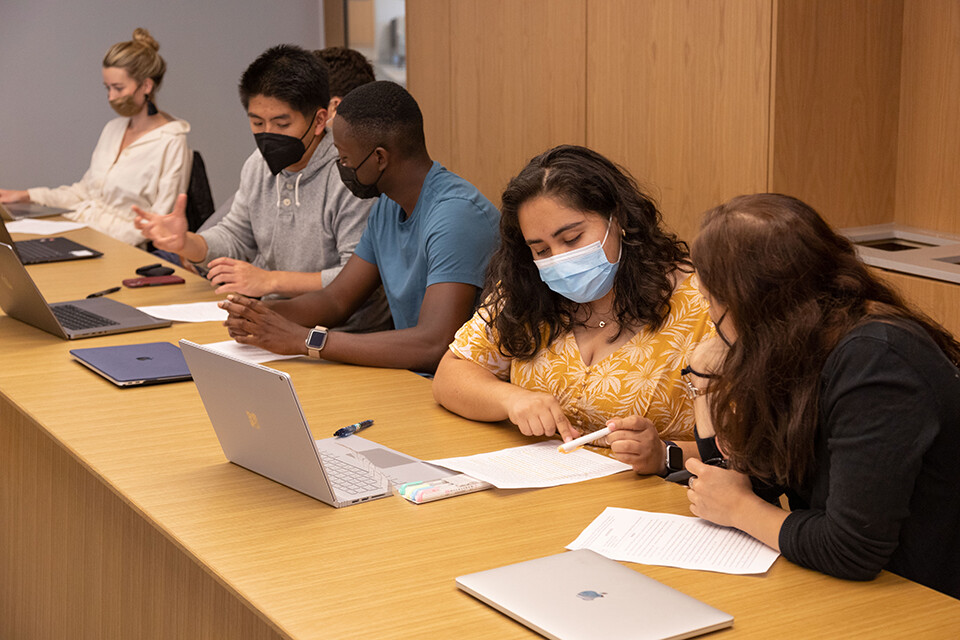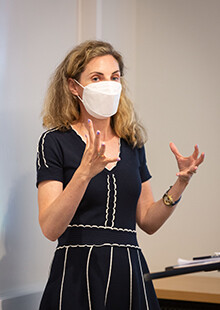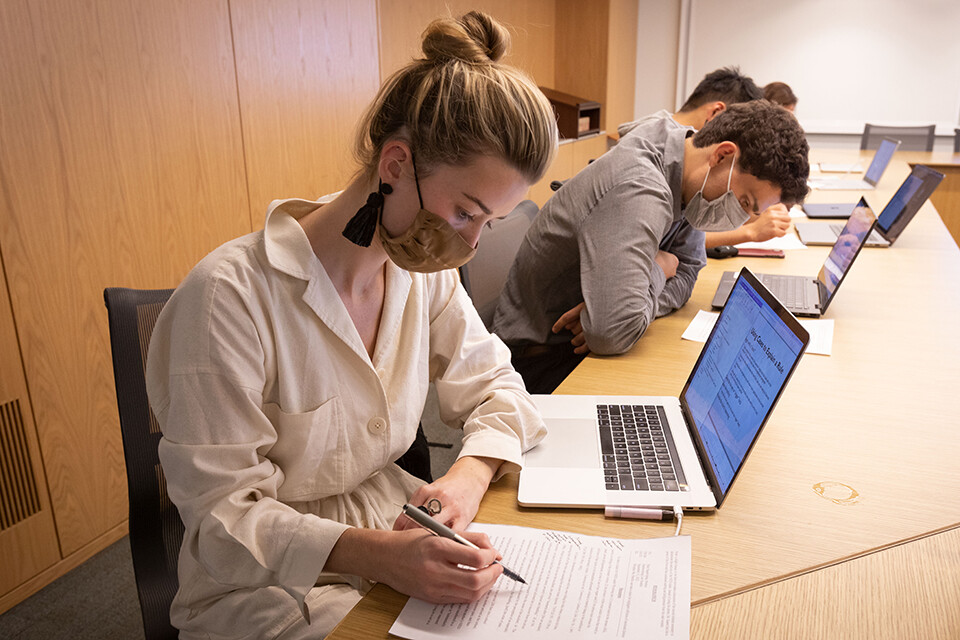Legal Writing Class Teaches More than Memos

It’s a short course with lofty goals.
That’s in the syllabus description for Introduction to Legal Analysis and Writing, an intensive course to help first-year students develop the essential skills of lawyering — all in their first seven weeks of law school. Known as ILAW, the course is primarily an introduction to legal writing. But ILAW takes a broader approach. Not only does the class teach students how to write one of the most widely used legal documents, it gives them a comprehensive range of lawyering tools.
From the first class, ILAW places students in the role of a lawyer, Director of Legal Research and Writing and Senior Research Scholar Cecilia A. Silver explained. Students identify legal issues, investigate facts, find relevant law, make strategic choices, and present analyses and conclusions.
“Essentially, we’re giving students the tools to approach — and solve — novel legal problems,” Silver said.

Training in legal writing for 1L students has always been a part of a Yale Law School education. Many alumni will remember first learning legal writing in their small group — the signature feature of the Yale Law School first year, when groups of 16 or so students take all their classes together — from teaching assistants known as Coker Fellows. The small group experience still includes instruction in legal writing, particularly briefs, and in legal research.
In recent years, the Law School has expanded its introduction to legal writing by creating ILAW as a separate class that meets weekly for the first half of the fall term. The shift acknowledges that not all students come to law school with the same writing experience. By having all new J.D. students take the course at the start of law school, students begin their legal education on equal footing. In doing so, the course reflects two tenets of Dean Heather K. Gerken’s leadership of the Law School: an emphasis on teaching skills as well as ideas, and a commitment to leveling the playing field.
“Part of what ILAW does is give all students a baseline introduction to legal writing, regardless of their previous writing instruction or exposure to lawyering,” Gerken said. “We meet our students where they are and get them where they are going. By giving students a solid foundation in the first weeks of law school, we prepare them for the wonderful careers they are embarking on.”
ILAW typically has about a dozen instructors each fall who represent a variety of legal careers. These practitioners include lawyers from area law firms, attorneys working for the government, practitioners serving the public interest, members of Yale’s Office of the General Counsel, and others who use legal writing in their day-to-day work.
The major assignment during ILAW is a closed-universe memo, or one based only on the research materials provided. A lawyer typically writes a memo to present an analysis to a supervising attorney, who uses that information to decide whether to assert a particular legal claim or defense, pursue a given case strategy, or advise a client to take a certain action.
Most law schools choose memos to introduce legal writing for good reason, Silver said. For one, memos teach organization and require students to keep in mind their audience — generally, other lawyers.

“Not unlike learning a foreign language, you don’t just need to build a new vocabulary,” Silver said. “You need to learn new organizational structures and new cultural expectations.”
That was the experience of Jonathan B. Epps ’24, who had a typical undergraduate background writing academic papers. But when it came to writing a legal memo “there was nothing I could really compare it to from writing or anything I had done in the past,” he said.
Like many students, Epps found the highly structured format of legal memos challenging. He also discovered that it took some time to learn how to cite documents according to The Bluebook. The style guide for U.S. lawyers has more than 500 pages of rules that students often find difficult to learn.
“A sentence had to go in a specific spot, or it’d be wrong,” Epps recalled of his first attempts to organize a memo. As for Bluebook citations, “I had to stay attached to the manual, and even that was confusing sometimes.” But Epps said the class made what could have been a stressful learning process manageable.
Though ILAW lasts only seven weeks, in that time “many of our superbly talented 1Ls do master the basics,” said Robert Harrison ’74, a Lecturer in Legal Method. Harrison said the instruction in legal writing and research that Yale Law School students receive in their first year is a foundation for what comes next.
“And for the 1Ls who may feel that they need more than a one-semester introduction to legal research and writing, we offer a wide variety of more advanced courses,” added Harrison, who has taught advanced legal writing for more than 30 years.
Silver also noted that students can practice what they learned in ILAW in simulation-based classes like civil pretrial litigation, trial practice, or advanced written advocacy. In addition, a substantial percentage of students hone their writing skills in the clinics, which often include opportunities to help write complaints, motions and other documents for actual lawsuits. Many students also receive additional writing practice in seminars and through independent work with faculty. The Law School’s instructors for advanced research and legal writing include practitioners, faculty, and Law Library staff.
“Lawyers send around 10,000 emails per year. That reality means that there are heaps of opportunities to stumble or thrive based on how well an attorney writes.” — Lecturer in the Practice of Law and Legal Writing Noah Messing ’00
To train students in memo writing, Silver designs the ILAW class assignment to mimic practice conditions. This year’s closed memo topic centers on a criminal law issue: specifically, whether a police officer’s questioning violated a client’s Fifth Amendment right against self-incrimination.
“I like using criminal law problems because the students are typically familiar with the concepts from books, TV, and movies, and the cases often feature interesting facts,” Silver said. “Pedagogically, the goal is to have the students analyze and rely on the law — rather than their intuition — in formulating their conclusion.”
There is another reason the memo focuses on criminal law. All students encounter this practice area in their first year, so no student will have an advantage, Silver explained. All sections of the class have the same syllabus and assignment topic for the same reason.
Over the span of half a semester, students outline, draft, and revise their memos. Each week, the class reviews, discusses, and dissects both strong and less successful examples of legal writing — structurally, logically, stylistically. Then the class identifies ways for the author to improve based on the tenets of good legal writing the class discussed that week.
When she took ILAW as a 1L, Nargis Aslami ’24 found it helpful when Silver provided portions of a memo, and the class identified ways that content could be refined, restructured, or made more concise.
“One of the things I found most helpful was Professor Silver’s mantra of ‘human first, lawyer second.’ Aslami said. “She quickly dispelled this sort of trope around legal writing being riddled with complex legal jargon by showing how we can still persuasively express our messages by using simple and concise language.”
The class’s “secret sauce,” according to Silver, is the detailed feedback that students receive. Along with their main assignments, students submit a written self-reflection to describe their approach. Instructors then respond in writing. For some assignments, instructors have individual conferences with students.

“We go line by line, word by word,” Silver said. “This process of examining examples, regularly practicing, receiving constructive criticism, and assimilating the instructors’ comments sets the students on a path to becoming great writers.”
There’s a practical reason for students to master memo writing early in their law school careers, Silver said. Memos are a staple of summer jobs.
Cameron Averill ’24 found that to be true working in the Massachusetts Attorney General’s Office last summer. He consulted his ILAW notes frequently while writing memos, “and my feedback from the office was nothing but positive,” he said.
Averill knows that legal writing will be essential to the career that most interests him, litigation. But even now, he finds memos useful for putting his thoughts about a particular doctrine in order.
“Elena Kagan has said that the key to clear legal writing is to really know the law,” Averill said. “I think the reverse is also true — sometimes to really know the law, you need to write it out.”
ILAW is meant to give students a solid background in memo writing, but the class also aims to produce lawyers who communicate well outside of legal documents. Today’s lawyers convey information in the workplace through a variety of means every day, Silver pointed out. They send emails, give PowerPoint presentations, and use messaging platforms like Slack and Teams. Though the class doesn’t specifically cover those formats, Silver said students who can write a solid memo will also be able to distill complex ideas into other concise forms.
“Reducing complicated topics to digestible, simple points under time pressure is the essence of being a good lawyer,” Silver said.
Lecturer in the Practice of Law and Legal Writing Noah Messing ’00, who has taught advanced legal writing at the Law School for more than a decade and also teaches a section of ILAW, agreed that the ability to write has always been essential for lawyers. One of his advanced courses trains students to advocate for their clients in writing. In an increasingly competitive profession, he said, even everyday communications are important.
“Lawyers send around 10,000 emails per year,” Messing said. “That reality means that there are heaps of opportunities to stumble or thrive based on how well an attorney writes.”
Even beyond learning to communicate like a lawyer, Silver said ILAW aims to help students form good professional habits. Seven weeks is a short time to cover, for example, cultural competence in the workplace or how to maintain good mental and physical health as a lawyer — both of which appear on the syllabus. But by introducing these topics early, Silver hopes ILAW can set students on the right path.
“My hope is that this exposure will help the 1Ls feel confident and prepared to succeed in their first-term classes, second semester, first legal summer internship, and beyond,” she said.


